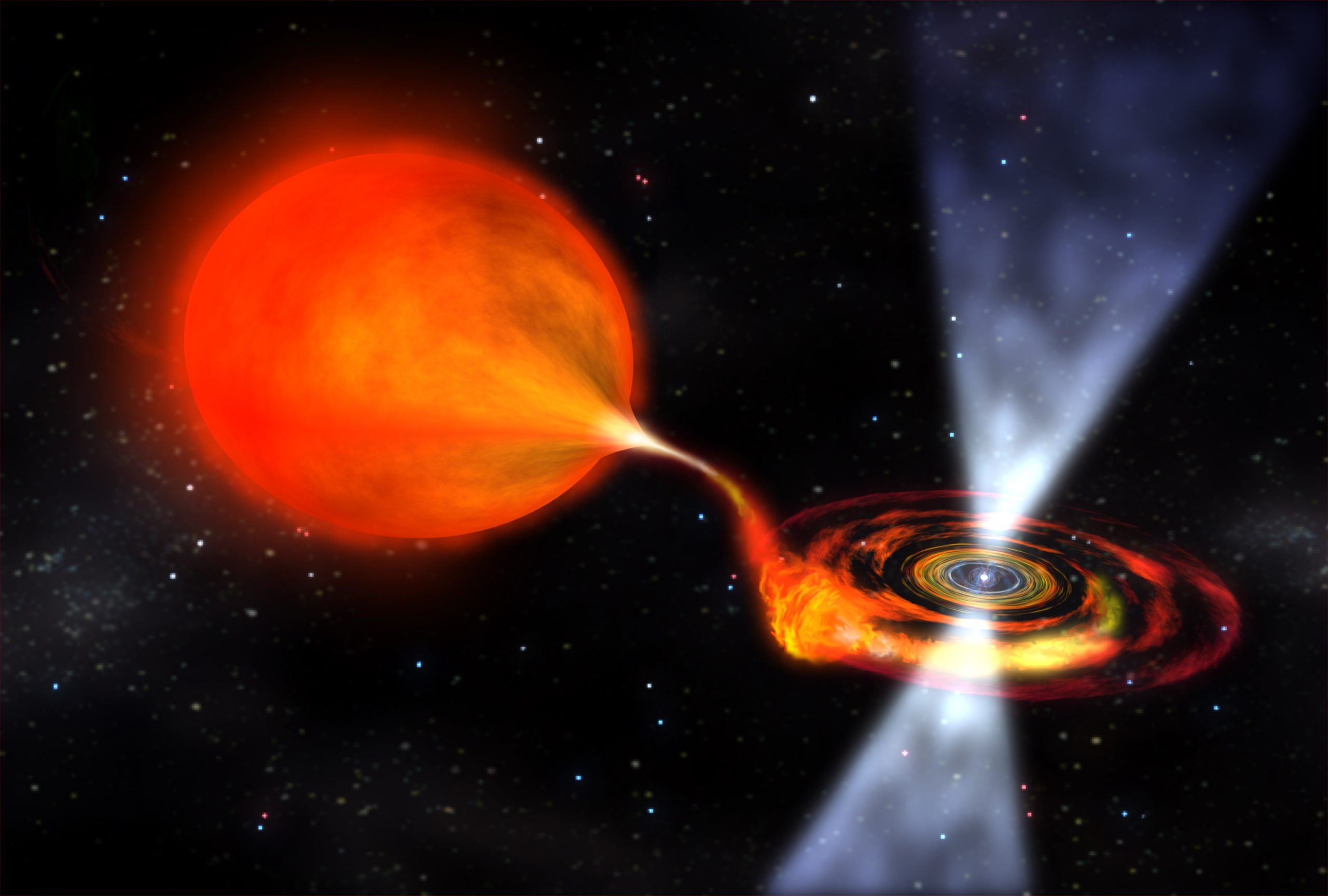Astronomen gebruiken sterverduisteringen om de atmosfeer te bestuderen van accretieschijven rond compacte sterren. SRON-onderzoekers hebben deze methode toegepast op röntgendubbelsterren met lage massa. Ze vinden een dikkere atmosfeer dan voorspeld en onderscheiden twee verschillende gascomponenten. Publicatie in Astronomy & Astrophysics.

Als je je op een heldere nacht in een donker gebied bevindt, kun je overweldigd worden door een gevoel van ontzag als je omhoog kijkt en beseft dat elk fonkelend puntje een enorme ster is, zo reusachtig als de Zon. Maar dat is nog niet alles. Bijna de helft van die puntjes bestaan uit twee sterren! Samen vormen ze een zogenoemde dubbelster. De sterren in deze systemen houden elkaar gevangen met hun aantrekkingskracht. Degene met de sterkere zwaartekracht ‘steelt’ materiaal van zijn begeleider en vormt een accretieschijf (zie figuur 1).
De exacte omvang en geometrie van accretieschijven zijn op dit moment niet bekend. Nieuwe modellen en röntgenobservaties duiden op een dikkere schijf dan oudere theoretische modellen voorspellen. Op de schijf zou een uitgebreide atmosfeer kunnen liggen. Maar hoe zie je die zonder dat de felle röntgenstralen van de schijf de hele observatie overbelichten? Dit probleem kun je oplossen door een geschikte röntgendubbelster te vinden die onder een dermate gunstige hoek ligt dat de begeleidende ster de accretieschijf blokkeert (zie figuur 2).
SRON-astronomen Ioanna Psaradaki, Elisa Costantini en Missagh Mehdipour selecteerden samen met Maria Diaz Trigo van ESO de ‘eclipsing’ dubbelster EXO 0748-676 en bestudeerden hem met de röntgenruimtetelescoop XMM-Newton. Het team koos een dubbelsysteem van twee sterren met lage massa, omdat zwaardere sterren sterke wind uitblazen die moeilijk te onderscheiden is van accretiestromen. Op sommige momenten verdwenen de aantrekkende ster en zijn accretieschijf volledig uit het zicht achter de begeleidende ster, zodat de onderzoekers erin slaagden om een spectrum te krijgen van de rijke atmosfeer van de schijf.
De eclipsmethode stelde de astronomen in staat om de atmosfeer directer te observeren dan eerdere studies. Ze bevestigen dat de atmosfeer dikker moet zijn dan voorspeld en dat het gas in de uitgebreide atmosfeer vóórkomt in twee verschillende vormen. De eerste gascomponent is heet, met een temperatuur vergelijkbaar met die van het onderste deel van de schijf. De tweede gascomponent is kouder en kleiner, en komt uit het buitenste gedeelte van de schijf. De onderzoekers vermoeden dat de tweede component bestaat uit klonters die zijn ontstaan uit de impact van de accretiestroom op de schijf.
‘De meest waarschijnlijke verklaring voor zo’n uitgebreide atmosfeer is dat de aantrekkende ster met zijn sterke röntgenstralen de buitenste delen van de accretieschijf foto-ioniseert,’ zegt Psaradaki. ‘Dit verschijnsel veroorzaakt thermische instabiliteit, terwijl het gas juist zoekt naar een stabiele oplossing. Die krijgt het als de schijf toeneemt in volume en zo een uitgebreide atmosfeer creëert, zoals blijkt uit onze resultaten.’
Publicatie
I. Psaradaki, E. Costantini, M. Mehdipour, and M. Díaz Trigo, ‘Modelling the disk atmosphere of the low mass X-ray binary EXO 0748-676’, Astronomy & Astrophysics


—————————————————————————————————————————–
—————————————————————————————————————————–
SRON-astronomers confirm extended atmosphere on accretion disk of X-ray binary
Astronomers use stellar eclipses to study the atmosphere of accretion disks around compact stars. SRON-researchers performed this method on a low-mass X-ray binary. They find a thicker atmosphere than predicted and distinguish two different gas components. Publication in Astronomy & Astrophysics.
If you find yourself in a dark area on a clear night, you might feel a sense of awe when you look up and realize that each dot is a full-grown star, as enormous as our Sun. But it gets better. Almost half of those dots consist of two stars! Together they form a so-called binary system. The stars in these systems hold each other captive with their gravitational pull. The one with the higher gravity ‘steals’ material from its companion star and forms an accretion disk (see figure 1).
Currently, the exact size and geometry of accretion disks are not clear. New models and X-ray observations propose that the vertical size of the disk is bigger than older theoretical models predict. There might be an extended atmosphere above the disk. But how do you see this without the X-ray bright disk overwhelming the observation? The solution is to find a suitable X-ray binary system at such a viewing angle that the companion star eclipses the bright disk (see figure 2).
SRON-astronomers Ioanna Psaradaki, Elisa Costantini and Missagh Mehdipour, together with Maria Diaz Trigo from ESO, selected the eclipsing binary system EXO 0748-676 and studied it with the X-ray space observatory XMM-Newton. The team chose a binary of two low-mass stars for their research, as more massive stars have strong outflowing winds that are hard to distinguish from accretion flows. At times the accreting star and its disk were completely eclipsed by the companion star, so the researchers managed to obtain a spectrum of the intriguing disk atmosphere.
The eclipse method enabled the astronomers to observe the atmosphere more directly than previous studies. They confirm that the atmosphere must be thicker than predicted and that the gas in the extended atmosphere appears in two different phases. The first gas component is hot, with a temperature close to that of the lower part of the disk. The second gas component is cooler and smaller in size, and comes from the outer part of the disk. The researchers propose that the latter component is clumpy material created by the impact of the accretion stream on the disk.
‘The most likely explanation for such an extended disk atmosphere is that the accreting star photoionizes the outer parts of the disk due to strong X-ray radiation,’ Psaradaki says. ‘This phenomenon causes thermal instabilities, while the gas tries to find a stable solution. This is made possible if the disk increases its volume and hence creates an extended atmosphere, as we saw in our research.’
Publication
I. Psaradaki, E. Costantini, M. Mehdipour, and M. Díaz Trigo, ‘Modelling the disk atmosphere of the low mass X-ray binary EXO 0748-676’, Astronomy & Astrophysics




